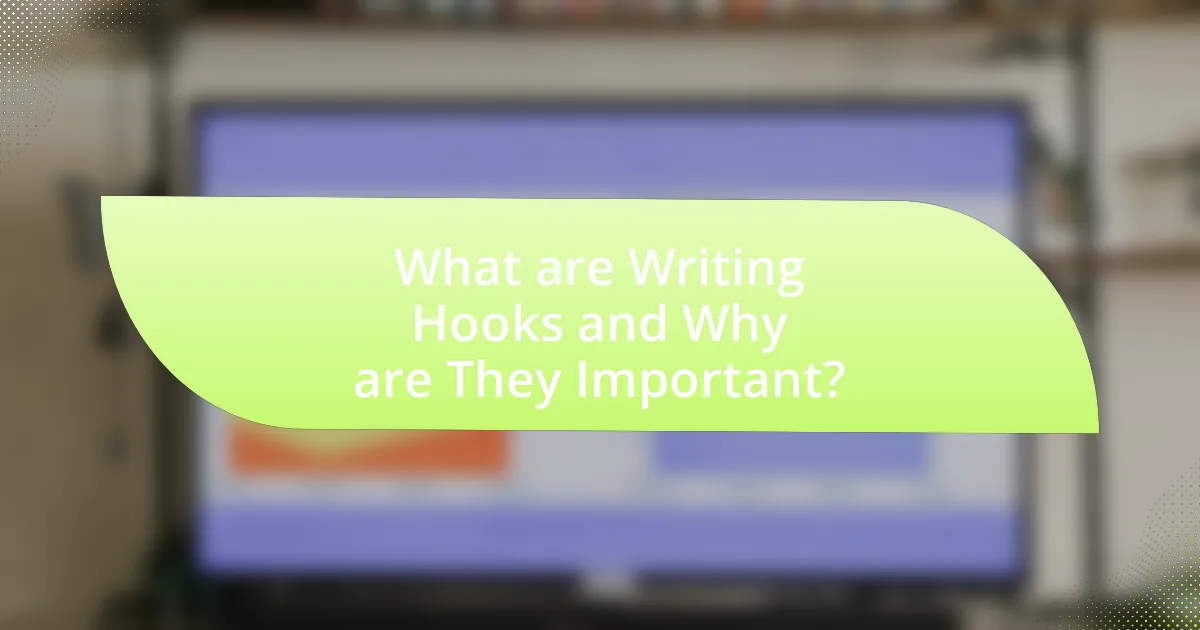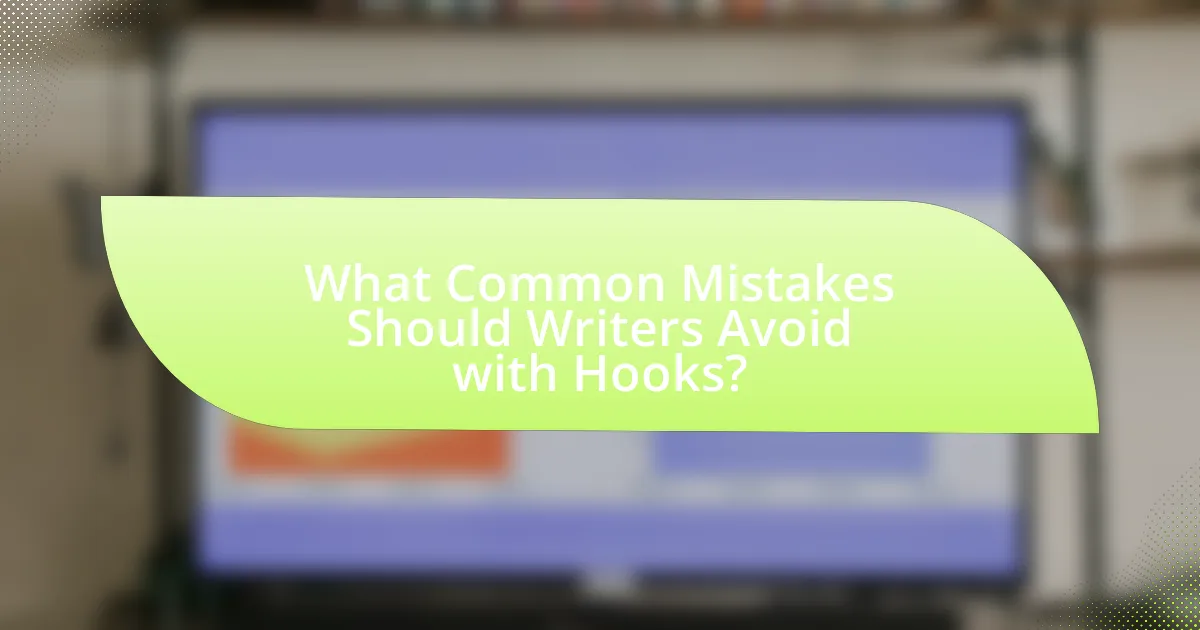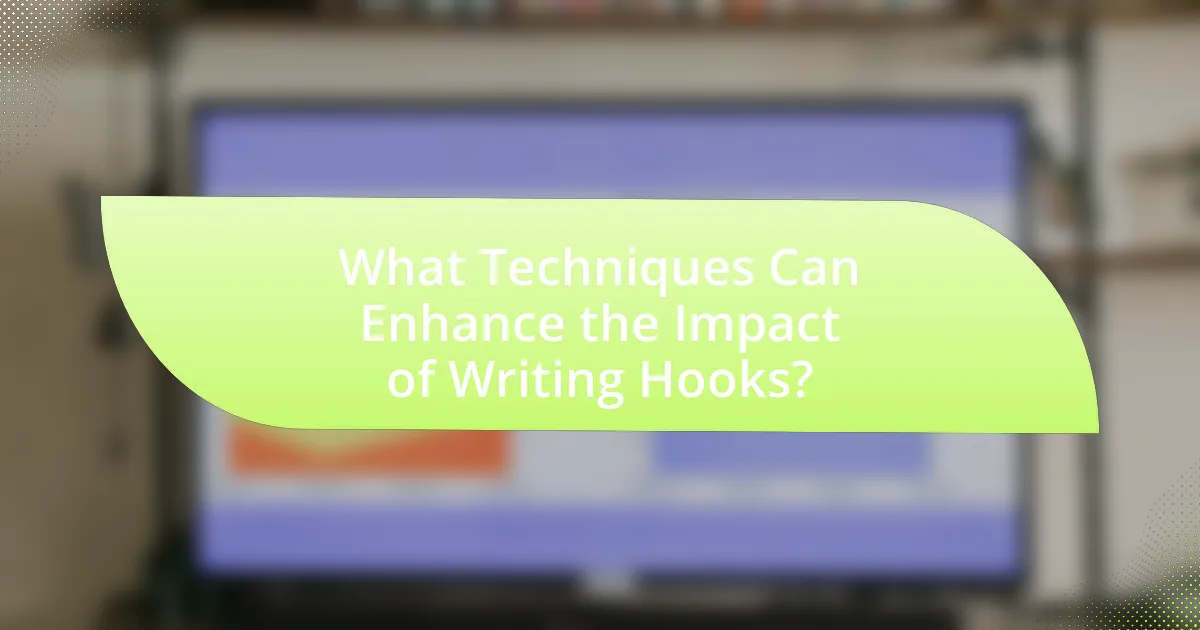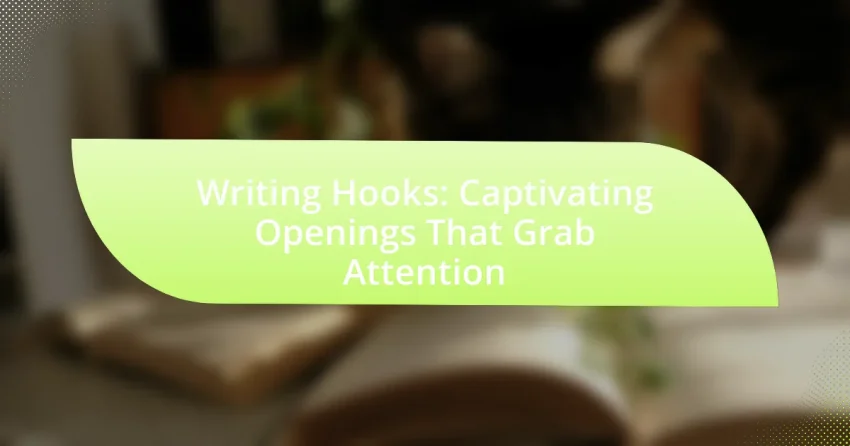Writing hooks are essential elements in writing that serve to immediately capture the reader’s attention and set the tone for the content. This article explores the significance of writing hooks, detailing how they engage readers through various techniques such as provocative questions, vivid imagery, and surprising facts. It examines the psychological principles that make hooks effective, the different types of hooks used across genres, and the common mistakes writers should avoid. Additionally, the article provides practical strategies for creating impactful hooks tailored to specific audiences, emphasizing the importance of clarity and originality in crafting compelling openings.

What are Writing Hooks and Why are They Important?
Writing hooks are compelling openings in a piece of writing designed to capture the reader’s attention immediately. They are important because they set the tone for the entire work and encourage readers to continue engaging with the content. Research indicates that readers often decide within the first few sentences whether to keep reading, making effective hooks crucial for maintaining interest and enhancing the overall impact of the writing.
How do Writing Hooks Capture Reader Attention?
Writing hooks capture reader attention by presenting intriguing or provocative statements that stimulate curiosity. These hooks often employ techniques such as asking questions, using vivid imagery, or presenting surprising facts, which compel readers to engage further with the text. For instance, a study published in the Journal of Educational Psychology found that opening lines that evoke emotional responses can significantly increase reader interest and retention. This demonstrates that effective writing hooks not only attract attention but also enhance the overall reading experience by creating an immediate connection with the audience.
What psychological principles make hooks effective?
Effective hooks leverage psychological principles such as curiosity, emotional engagement, and the principle of scarcity. Curiosity piques interest by presenting an intriguing question or scenario, compelling readers to seek answers. Emotional engagement connects with the audience’s feelings, making the content relatable and memorable. The principle of scarcity creates urgency, suggesting that the information is limited or exclusive, prompting immediate attention. Research by Cialdini (2009) in “Influence: Science and Practice” supports these principles, demonstrating how they can significantly enhance engagement and retention in communication.
How do hooks influence a reader’s first impression?
Hooks significantly influence a reader’s first impression by capturing attention and setting the tone for the content. A well-crafted hook, such as a provocative question, a surprising fact, or a vivid description, engages the reader immediately, prompting them to continue reading. Research indicates that readers often make quick judgments about the quality and relevance of a text based on its opening lines, with studies showing that 80% of readers will read only the headline or first few sentences before deciding to engage further. This demonstrates that effective hooks are crucial for establishing interest and encouraging deeper exploration of the material.
What Types of Writing Hooks Exist?
There are several types of writing hooks that effectively capture readers’ attention. These include questions, quotes, anecdotes, startling statements, and vivid descriptions. Questions engage readers by prompting them to think about the topic, while quotes can lend authority or provoke thought. Anecdotes provide relatable stories that draw readers in, startling statements can shock or surprise, and vivid descriptions create strong imagery that captivates the audience. Each type serves to pique interest and encourage further reading, making them essential tools in writing.
What are the most common types of hooks used in writing?
The most common types of hooks used in writing include questions, quotes, anecdotes, startling statements, and vivid descriptions. Questions engage readers by prompting them to think about the topic, while quotes can lend authority or provoke thought. Anecdotes provide relatable stories that draw readers in, and startling statements capture attention through surprise. Vivid descriptions create strong imagery that immerses readers in the narrative. Each type of hook serves to pique interest and encourage further reading, making them essential tools in effective writing.
How does each type of hook serve different writing purposes?
Each type of hook serves distinct writing purposes by engaging the reader in different ways. For instance, a question hook prompts curiosity, encouraging readers to seek answers within the text. A quote hook can lend authority or emotional resonance, establishing a connection with the audience through familiar or impactful words. Anecdotal hooks provide relatable narratives that draw readers in by evoking personal experiences or emotions. Statistical hooks present compelling data that can persuade or inform, appealing to the reader’s logical reasoning. Each hook type strategically aligns with the writer’s intent, whether to provoke thought, evoke emotion, or present information, thereby enhancing the overall effectiveness of the writing.
What Role do Writing Hooks Play in Different Genres?
Writing hooks serve as essential tools in various genres to capture readers’ attention and establish tone. In fiction, hooks often introduce conflict or intrigue, compelling readers to continue; for example, a mystery novel might start with a crime scene, immediately engaging the audience’s curiosity. In non-fiction, hooks can present startling statistics or provocative questions, drawing readers into the subject matter; a health article might begin with a shocking fact about disease prevalence to emphasize urgency. Each genre utilizes hooks tailored to its audience’s expectations, ensuring that the opening lines resonate and encourage further reading.
How do hooks differ between fiction and non-fiction writing?
Hooks in fiction and non-fiction writing differ primarily in their purpose and approach. Fiction hooks aim to engage readers emotionally and create intrigue, often through compelling characters, dramatic situations, or imaginative settings. In contrast, non-fiction hooks focus on presenting facts, questions, or statements that provoke thought or curiosity, aiming to inform or persuade the reader. For example, a fiction hook might start with a dramatic event, while a non-fiction hook could present a startling statistic or a provocative question. This distinction is crucial as it shapes the reader’s expectations and the overall tone of the writing.
What specific techniques are effective in academic writing hooks?
Effective techniques in academic writing hooks include posing a provocative question, presenting a surprising fact or statistic, and using a relevant quote. Posing a provocative question engages the reader’s curiosity and encourages them to think critically about the topic. Presenting a surprising fact or statistic can capture attention by challenging common assumptions, as evidenced by studies showing that unexpected information increases reader engagement. Using a relevant quote can lend authority to the writing and connect the reader emotionally to the subject matter, enhancing their interest. These techniques are supported by research indicating that strong openings significantly improve reader retention and interest in academic texts.
How can Writers Create Effective Hooks?
Writers can create effective hooks by starting with a compelling question, a surprising fact, or a vivid image that captures the reader’s attention immediately. For instance, using a startling statistic can intrigue readers, as studies show that 55% of readers decide whether to continue reading based on the first sentence. Additionally, employing emotional language or relatable scenarios can engage readers on a personal level, making them more likely to invest in the content. These strategies are supported by research indicating that hooks significantly influence reader engagement and retention.
What strategies can be employed to brainstorm hook ideas?
To brainstorm hook ideas, utilize strategies such as free writing, mind mapping, and audience analysis. Free writing encourages the generation of spontaneous thoughts without self-editing, allowing for creative and unexpected hook ideas to emerge. Mind mapping visually organizes concepts and connections, helping to identify unique angles for hooks. Audience analysis involves understanding the preferences and interests of the target demographic, which can guide the creation of hooks that resonate with them. These strategies are effective because they foster creativity and ensure relevance, enhancing the likelihood of capturing attention.
How can writers tailor hooks to their target audience?
Writers can tailor hooks to their target audience by understanding the audience’s interests, preferences, and pain points. This involves conducting research to identify what resonates with the specific demographic, such as using relatable language, addressing common challenges, or incorporating relevant cultural references. For instance, a study by the Pew Research Center indicates that content that aligns with the audience’s values and experiences is more likely to engage them effectively. By aligning the hook with the audience’s expectations and emotional triggers, writers can create compelling openings that capture attention and encourage further reading.

What Common Mistakes Should Writers Avoid with Hooks?
Writers should avoid using clichés as hooks, as they fail to engage readers effectively. Clichés, such as “Once upon a time” or “In a world where,” are overused phrases that do not capture attention or spark curiosity. Instead, writers should strive for originality and creativity in their openings to create a strong first impression. Additionally, writers should avoid being overly vague or abstract, as this can confuse readers and diminish interest. Clear and compelling hooks that provide a glimpse into the story or argument are essential for drawing readers in. Lastly, writers should refrain from making hooks too long or complex, as brevity and clarity are crucial for maintaining reader engagement.
What are the pitfalls of using clichés in writing hooks?
Using clichés in writing hooks can lead to a lack of originality and engagement. Clichés often fail to capture the reader’s attention because they are overused phrases that lack freshness and creativity. This predictability can result in readers losing interest quickly, as they may feel they have already encountered the same ideas elsewhere. Additionally, reliance on clichés can undermine the writer’s credibility, as it may suggest a lack of effort or thoughtfulness in crafting unique content. Studies in writing pedagogy indicate that original hooks significantly enhance reader engagement, highlighting the importance of creativity in effective writing.
How can clichés undermine the effectiveness of a hook?
Clichés undermine the effectiveness of a hook by making it predictable and unoriginal, which fails to capture the audience’s attention. When a hook relies on overused phrases or ideas, it lacks the novelty that engages readers, leading to disinterest. Research indicates that unique and fresh language is more likely to resonate with audiences, as demonstrated in a study by the University of Southern California, which found that originality in writing significantly increases reader engagement. Thus, using clichés diminishes the potential impact of a hook by failing to intrigue or provoke thought.
What alternatives can writers use instead of clichés?
Writers can use original metaphors, vivid imagery, and specific anecdotes instead of clichés. Original metaphors create fresh comparisons that engage readers, while vivid imagery paints a clear picture, enhancing emotional connection. Specific anecdotes provide relatable and unique experiences that draw readers in, making the writing more personal and impactful. These alternatives not only avoid the pitfalls of overused phrases but also enrich the narrative, fostering a deeper connection with the audience.
How can Overly Complex Hooks Affect Reader Engagement?
Overly complex hooks can negatively impact reader engagement by confusing or alienating the audience. When hooks are convoluted, they fail to clearly convey the main idea, leading to a lack of interest or understanding. Research indicates that clarity in writing significantly enhances reader retention and engagement; for instance, a study published in the Journal of Educational Psychology found that simpler language improves comprehension and keeps readers focused. Therefore, using straightforward and relatable hooks is essential for maintaining reader interest and ensuring effective communication.
What makes a hook too complex or confusing?
A hook becomes too complex or confusing when it incorporates excessive jargon, convoluted sentence structures, or multiple ideas that overwhelm the reader. For instance, hooks that use specialized terminology without context can alienate a general audience, making it difficult for them to grasp the intended message. Research indicates that clarity and simplicity are crucial for effective communication; a study by the Nielsen Norman Group found that users prefer straightforward language that conveys ideas quickly. Therefore, hooks should aim for clarity and directness to engage readers effectively.
How can simplicity enhance the effectiveness of a hook?
Simplicity enhances the effectiveness of a hook by making it easily understandable and memorable for the audience. A straightforward hook captures attention quickly, allowing readers to grasp the main idea without confusion. Research indicates that clear and concise language increases engagement; for instance, studies show that messages with fewer complex words are more likely to be retained by readers. Therefore, a simple hook not only attracts attention but also facilitates better retention and comprehension, ultimately leading to a more impactful opening.

What Techniques Can Enhance the Impact of Writing Hooks?
Techniques that can enhance the impact of writing hooks include using provocative questions, vivid imagery, and surprising facts. Provocative questions engage readers by prompting them to think critically about the topic, while vivid imagery creates a strong mental picture that draws readers in. Surprising facts capture attention by presenting unexpected information that piques curiosity. Research indicates that hooks utilizing these techniques can increase reader engagement and retention, as evidenced by studies showing that content with compelling openings is more likely to be shared and remembered.
How can emotional appeal be integrated into writing hooks?
Emotional appeal can be integrated into writing hooks by using evocative language that resonates with the reader’s feelings and experiences. This technique captures attention by triggering emotions such as joy, sadness, fear, or nostalgia, making the content relatable and engaging. For instance, a hook that begins with a personal story or a poignant question can immediately draw readers in by connecting with their emotions. Research shows that emotionally charged content is more likely to be remembered and shared, as demonstrated in a study by the University of Pennsylvania, which found that emotionally resonant stories increase engagement and retention.
What emotions are most effective in engaging readers?
The emotions most effective in engaging readers are curiosity, empathy, and surprise. Curiosity drives readers to seek answers and explore further, as evidenced by studies showing that headlines that evoke curiosity can increase click-through rates by up to 300%. Empathy allows readers to connect with characters or situations, enhancing their emotional investment; research indicates that narratives that elicit empathy can lead to greater reader engagement and retention. Surprise captures attention and keeps readers intrigued, with psychological studies revealing that unexpected elements in storytelling can significantly enhance memory recall and interest.
How can storytelling elements enhance a hook’s appeal?
Storytelling elements enhance a hook’s appeal by creating emotional connections and engaging the audience’s imagination. When a hook incorporates elements such as character, conflict, and setting, it draws readers in by making them invest in the narrative. For example, hooks that introduce a relatable character facing a compelling challenge can evoke empathy and curiosity, prompting readers to want to learn more. Research indicates that narratives with strong emotional components are more memorable and persuasive, as demonstrated in studies by Paul Zak, which show that storytelling can increase oxytocin levels, fostering connection and engagement. Thus, integrating storytelling elements into a hook not only captures attention but also enhances retention and emotional resonance.
What Role Does Context Play in Crafting Hooks?
Context plays a crucial role in crafting hooks by providing the necessary background and relevance that capture the audience’s attention. When hooks are tailored to the specific context of the audience, such as their interests, cultural references, or current events, they become more engaging and relatable. For example, a hook referencing a trending topic or a shared experience can resonate more deeply with readers, increasing the likelihood of drawing them into the content. Research indicates that contextually relevant hooks can improve reader engagement by up to 50%, demonstrating the importance of aligning hooks with the audience’s situational awareness and emotional state.
How can current events influence the relevance of a hook?
Current events can significantly influence the relevance of a hook by aligning the content with contemporary issues that resonate with the audience. When a hook references timely topics, such as political developments, social movements, or trending news stories, it captures attention more effectively because it taps into the audience’s immediate interests and concerns. For example, during a global health crisis, a hook that discusses health-related themes will likely engage readers more than one that does not consider the current context. This alignment with current events enhances the hook’s impact, making it more relatable and compelling for the audience.
What factors should be considered regarding the publication platform?
The factors to consider regarding the publication platform include audience reach, platform credibility, content format compatibility, and monetization options. Audience reach determines how many potential readers can access the content, influencing visibility and engagement. Platform credibility affects the perceived value of the content; reputable platforms enhance trust and authority. Content format compatibility ensures that the publication platform supports various media types, such as text, images, and videos, which can enhance the effectiveness of hooks. Lastly, monetization options are crucial for authors seeking financial benefits from their work, as different platforms offer varying revenue models.
What Practical Tips Can Help Writers Develop Strong Hooks?
Writers can develop strong hooks by starting with a compelling question, using vivid imagery, or presenting an intriguing fact. These techniques immediately engage readers’ curiosity and emotions. For instance, beginning with a provocative question can prompt readers to think critically about the topic, while vivid imagery can create a strong mental picture that draws them in. Presenting an intriguing fact can also capture attention by offering surprising or little-known information, making readers eager to learn more. Research indicates that hooks that evoke emotional responses or curiosity significantly increase reader engagement, as shown in studies on effective writing techniques.
How can writers practice creating hooks effectively?
Writers can practice creating hooks effectively by analyzing successful examples and experimenting with different techniques. By studying the openings of bestselling novels or popular articles, writers can identify what makes those hooks compelling, such as intriguing questions, vivid imagery, or surprising statements. Additionally, writers should engage in exercises that focus on brevity and impact, such as writing multiple hooks for the same topic and soliciting feedback from peers. Research indicates that writers who actively seek feedback and revise their hooks based on constructive criticism improve their ability to engage readers.
What resources are available for improving hook-writing skills?
Resources available for improving hook-writing skills include books, online courses, and writing workshops. Notable books such as “The Writer’s Idea Book” by Jack Heffron provide practical exercises for generating engaging openings. Online platforms like Coursera and Udemy offer courses specifically focused on creative writing techniques, including crafting hooks. Additionally, writing workshops, both in-person and virtual, often emphasize the importance of strong openings and provide feedback on participants’ work. These resources collectively enhance the ability to write compelling hooks that capture readers’ attention.
